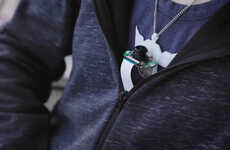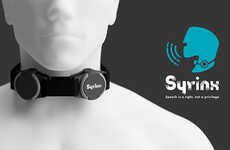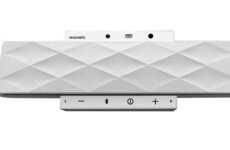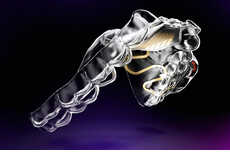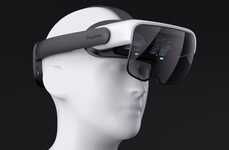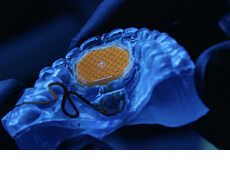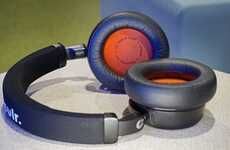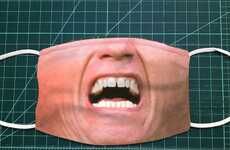
Audeo
References: theaudeo & technology.newscientist
Finally, a way for that annoying guy next to me at Starbucks to yap on his phone without making noise! The first "voiceless" phone call has been demonstrated at a recent conference held by microchip manufacturer Texas Instruments utilizing a new technology via a neckband that translates thought into speech by picking up nerve signals. Users can send nerve signals to their vocal cords without making a sound. These signals are then picked up by the neckband (called Audeo) and relayed wirelessly to a computer that converts them into words spoken by a computerised voice.
You don't have to worry about the system voicing your inner dark & naughty thoughts though, producing signals for the Audeo to decipher requires "a level above thinking". Users must think specifically about voicing words for them to be picked up by the equipment.
The demonstrated system can recognise only a limited set of about 150 words and phrases. At the end of the year an improved version is set to be released without a vocabulary limit. Instead of recognising whole words or phrases, it should identify the individual phonemes that make up complete words. The phoneme-based system will be aimed at people who have lost the ability to speak due to neurological diseases like ALS – also known as motor neurone disease.
You don't have to worry about the system voicing your inner dark & naughty thoughts though, producing signals for the Audeo to decipher requires "a level above thinking". Users must think specifically about voicing words for them to be picked up by the equipment.
The demonstrated system can recognise only a limited set of about 150 words and phrases. At the end of the year an improved version is set to be released without a vocabulary limit. Instead of recognising whole words or phrases, it should identify the individual phonemes that make up complete words. The phoneme-based system will be aimed at people who have lost the ability to speak due to neurological diseases like ALS – also known as motor neurone disease.
Trend Themes
1. Voiceless Communication - The development of nerve-tapping neckbands opens up opportunities for voiceless communication using thought-to-speech translation technology.
2. Neurological Disease Support - The phoneme-based system has disruptive innovation potential in providing communication solutions for individuals with neurological diseases that have lost the ability to speak.
3. Enhanced Speech Recognition - The improved version of the neckband technology, capable of recognizing individual phonemes, presents opportunities for advancements in speech recognition technology.
Industry Implications
1. Healthcare - The neurological disease support technology has applications in the healthcare industry to assist patients with communication impairments.
2. Consumer Electronics - Voiceless communication devices like the nerve-tapping neckband have the potential to disrupt the consumer electronics industry by offering new ways to interact with technology.
3. Software Development - Advancements in speech recognition technology driven by the enhanced neural neckband technology create opportunities for software developers in various industries to improve voice-controlled applications.
2.8
Score
Popularity
Activity
Freshness


